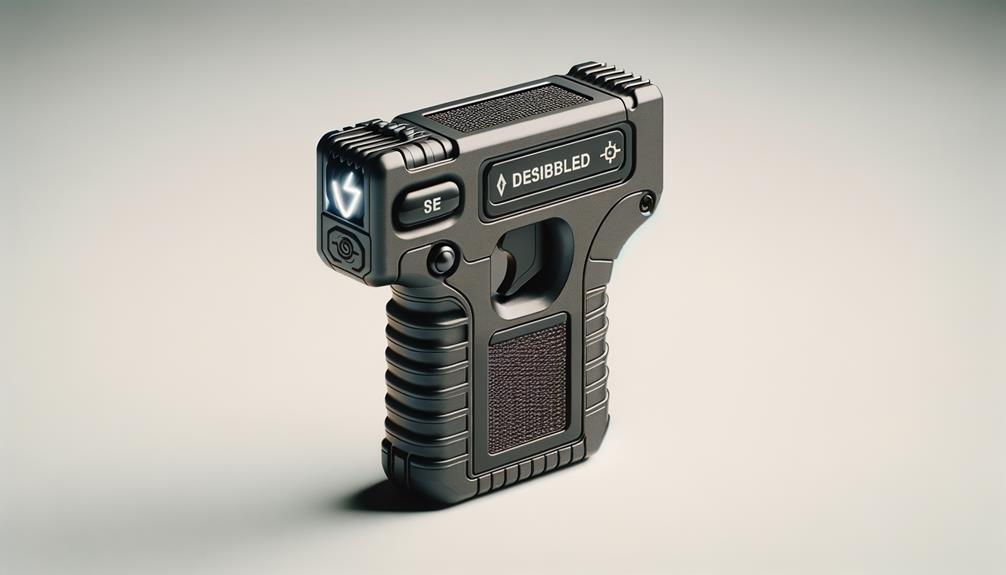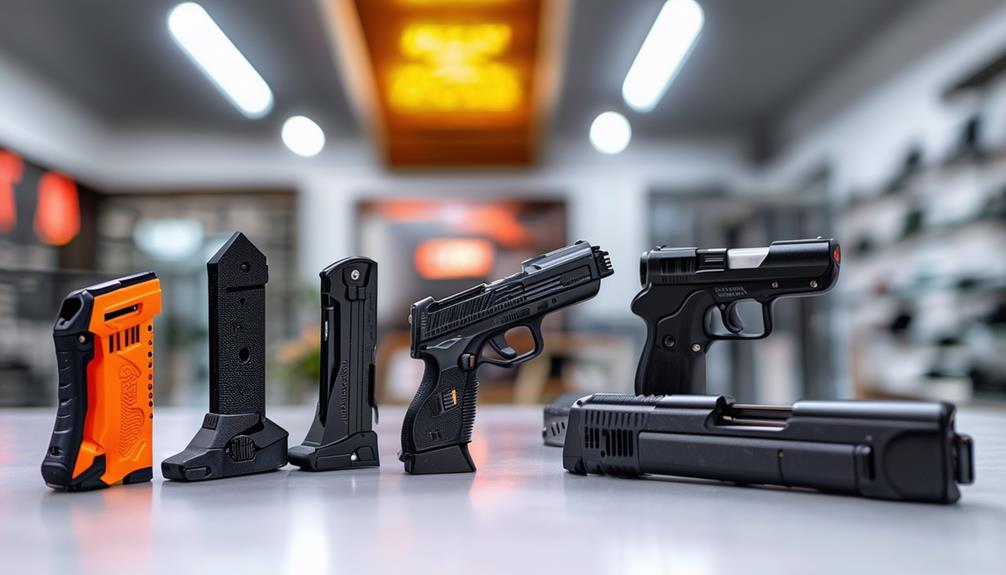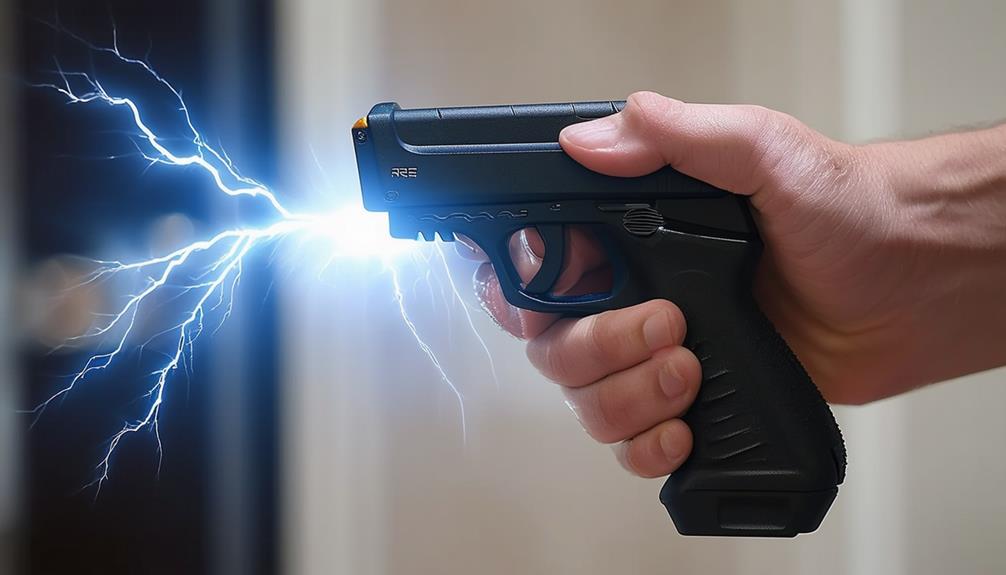
Brainstorm Security Shop

For Orders Over $199

On Any Of Our Products

Details On Refund Page
Ever wondered about the inner workings of stun guns? Picture this: a small, handheld device capable of delivering a shocking jolt that can incapacitate an attacker swiftly and effectively. But how does it achieve this stunning feat? By harnessing the power of electricity in a precise and calculated manner. The science behind stun guns is both fascinating and practical, offering a glimpse into the innovative technology that drives their functionality. Stay tuned to uncover the electrifying details behind how stun guns operate and the impact they have on the human body.
Stun guns, also known as tasers, are non-lethal self-defense weapons that deliver an electric shock to incapacitate an attacker. These devices are designed to provide a powerful jolt of electricity upon contact with the target, causing temporary disruption to the attacker’s neuromuscular system. The electric shock emitted by a stun gun interferes with the body’s communication between the brain and muscles, resulting in disorientation and loss of muscle control.
One key advantage of stun guns is their effectiveness in disabling an assailant without causing permanent harm. Unlike lethal weapons, stun guns are intended to subdue the target temporarily, allowing the victim to escape from a dangerous situation. Stun guns come in various shapes and sizes, with some models designed for discreet carrying in purses or pockets, while others are equipped with additional features like flashlights or disabling pins.
When considering a self-defense tool, stun guns can offer a valuable option for personal safety. It’s essential to familiarize yourself with the proper operation and regulations surrounding stun gun use to ensure effective and safe utilization in potential threatening situations.

Exploring the internal components and overall structure of stun guns provides insight into how these self-defense devices function effectively. A typical stun gun consists of a few key parts. The main component is the battery, which powers the device. Connected to the battery is the circuit board, which includes the voltage converter and other electronic components responsible for delivering the shock. The electrodes are located at the front end of the stun gun and are what come into direct contact with the target. These electrodes are often spaced apart to create a spark or arc of electricity.
In terms of structure, stun guns are usually designed to be compact and easy to carry. They’re shaped to fit comfortably in your hand, with a trigger or button located for easy access. The housing of the stun gun is typically made of durable plastic or metal to protect the internal components.
Understanding the components and structure of stun guns is crucial in comprehending how they’re able to incapacitate an attacker effectively.
To generate an electric shock in a stun gun, the battery supplies power to the circuit board which then converts the voltage to create the desired effect. When you activate the stun gun by pressing the trigger, the circuit board rapidly accumulates an electrical charge from the battery.
This stored charge is then released through a set of wires connected to the prongs at the end of the device. As the electrical current flows through these prongs, it creates a high-voltage, low-amperage electrical arc. The arc produces a crackling sound and visible sparks as the electric current jumps between the prongs.
This phenomenon isn’t the shock itself but a visible indication of the electrical discharge. When the stun gun is pressed against an object or a person, the electrical arc creates a conductive path, allowing the electric current to flow into the target and disrupt the normal functioning of the muscles temporarily. This disruption causes pain and can incapacitate the target, providing a self-defense mechanism without causing long-term harm.
When the electrical current from a stun gun enters the body, it interferes with the nervous system’s normal functioning, causing temporary incapacitation. The sudden shock disrupts the signals being sent between the brain and the muscles, overwhelming the nervous system. This disruption leads to a loss of muscle control and coordination, making it difficult for you to move or react effectively.
The impact on the nervous system can also result in pain, muscle contractions, and disorientation.
The electrical impulses emitted by the stun gun override the body’s natural electrical signals, confusing the nervous system and preventing it from functioning properly. This confusion causes the muscles to contract involuntarily, contributing to the incapacitating effect of the stun gun.
Understanding the relationship between voltage and amperage is crucial to grasping how stun guns work effectively. Voltage, measured in volts, refers to the force that pushes electrical current through a circuit. In the case of stun guns, higher voltage results in a more powerful electric discharge. This high voltage is what allows the electric current to overcome the body’s natural resistance, making the stun gun effective in incapacitating an individual temporarily.
Amperage, on the other hand, is the measure of the actual flow of electricity, expressed in amperes. While voltage determines the strength of the electrical push, amperage influences the intensity of the shock experienced by the target.
Stun guns are designed to deliver a high voltage but low amperage shock. This low amperage ensures that the electric current doesn’t cause long-term harm or fatality, making stun guns a non-lethal self-defense option.
Safety features incorporated into stun guns are essential to ensure their proper and responsible use. One crucial safety feature is the on/off switch, which helps prevent accidental discharge and allows you to control when the stun gun is active.
Another important feature is the safety mechanism that requires the user to activate it before the stun gun can be used, reducing the risk of unintentional activation.
It’s also vital to consider the design of the stun gun. Look for models with a textured grip to prevent it from slipping out of your hand during use. Additionally, some stun guns come with built-in LED lights, which can be useful for illumination in dark or low-light situations, adding an extra layer of safety.
When handling a stun gun, always keep it away from children and store it in a secure place. Remember to regularly check the battery life and ensure it’s fully charged when needed.
To gauge the effectiveness of stun guns, hearing testimonials from individuals who’ve used them in self-defense situations can provide valuable insights. Many people have shared their experiences of successfully using stun guns to deter attackers and protect themselves from harm. These testimonials often highlight the quick incapacitation effect of stun guns, allowing the user to escape dangerous situations without causing long-term harm to the assailant.
Individuals who’ve used stun guns in real-life scenarios often praise their ease of use and portability, making them convenient tools for personal protection. The loud crackling sound and visible electrical arc produced by stun guns can also act as deterrents, potentially preventing physical confrontations altogether.
Moreover, many users have reported feeling more empowered and confident when carrying a stun gun, knowing they have a non-lethal option to defend themselves in case of an emergency.

How do legal regulations impact the possession and use of stun guns in various jurisdictions?
Stun gun laws vary widely across different states and countries, so it’s crucial to understand the specific regulations in your area.
In some places, stun guns are completely banned, while in others they’re legal for personal use with certain restrictions.
For example, in some states in the U.S., there may be restrictions on who can purchase or carry a stun gun, such as age requirements or background checks.
Additionally, some jurisdictions may have specific rules regarding where you can carry a stun gun, such as prohibiting them in certain public places like schools or government buildings.
It’s important to do thorough research and familiarize yourself with the laws governing stun guns in your area to ensure that you’re using them legally and responsibly.
Violating stun gun regulations can result in serious legal consequences, so it’s crucial to stay informed and compliant with the laws that apply to you.
Understanding how to properly use and maintain your stun gun is key to ensuring its effectiveness and longevity. When using your stun gun, always aim for the largest muscle areas on the body, such as the thighs or the abdomen, for maximum effectiveness. Remember to keep a safe distance from the target to prevent it from being able to grab the stun gun from you. After each use, recharge your stun gun to ensure it’s ready for the next potential threat.
Proper maintenance is essential for your stun gun to function correctly. Regularly check the battery to ensure it’s fully charged, and replace it if needed. Keep the electrodes clean by wiping them with a damp cloth and make sure the safety switch is functioning properly. Additionally, store your stun gun in a cool and dry place to prevent any damage.
You now understand how stun guns work by converting electrical energy into a high-voltage shock that disrupts the target’s neuromuscular system.
By creating a conductive path for the current to flow through the body, stun guns override nerve signals, causing pain and muscle contractions.
Remember to always consider safety features and regulations when using stun guns, and ensure proper usage and maintenance for effectiveness.
Stay informed and stay safe.

Brainstorm Security Shop
1867 Caravan Trail
Ste 105
Jacksonville, FL 32216
Call us toll free: (800) 859-5566